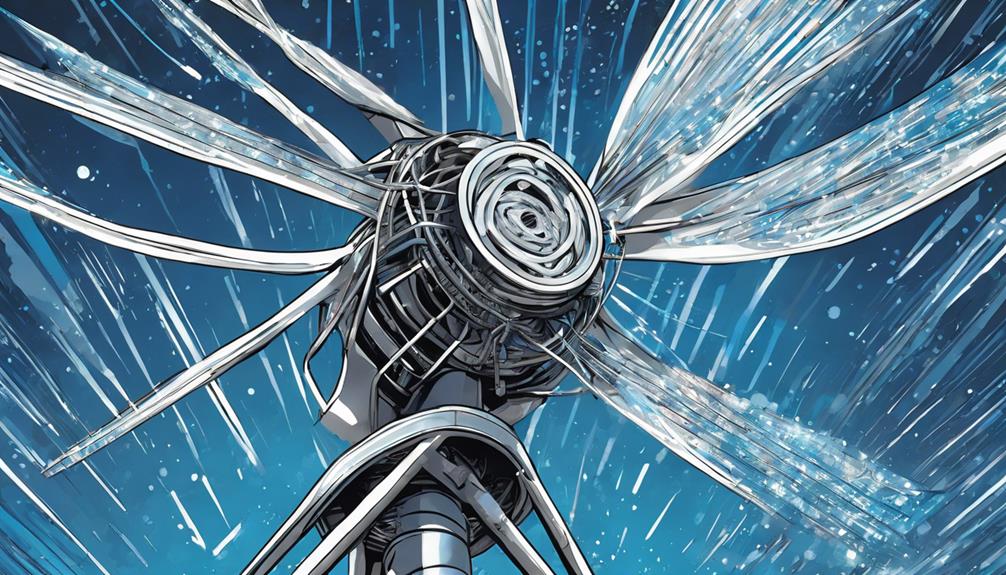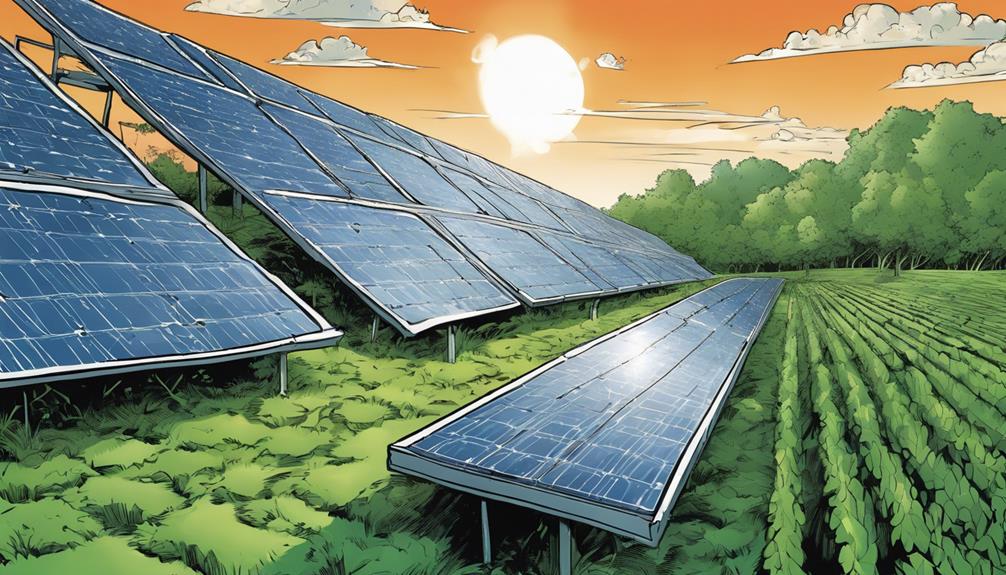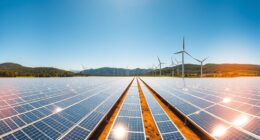To make geothermal energy, it usually takes 4 to 7 years from getting permits to full operation. Geothermal projects have potential but come with challenges in the sustainable energy field.
Key Takeaways
- Geothermal projects take 5-10 years from development to operational readiness.
- Challenges include drilling risks and uncertainties in well productivity.
- Regulatory understanding is crucial for successful project implementation.
- Geothermal energy requires a clear policy and legal framework for growth.
- Initial equity commitments and debt financing are essential for funding geothermal projects.
Geothermal Development Timeframes
Geothermal energy projects typically require an average of 5.5 years to progress from the planning stage to operational readiness. This timeline in geothermal development is pivotal as it encompasses various phases, from securing permits to actual operation.
Compared to other renewable energy sources like solar and wind, geothermal projects take longer, with an average of 4 to 7 years from permit acquisition to becoming fully operational. The geothermal industry faces unique challenges, such as the high risks associated with drilling unproductive wells, which greatly contribute to the extended project development times.
Each phase of a geothermal project constitutes a substantial portion of its total lifespan, with project development times typically ranging from 5 to 10 years. Despite the longer timelines, geothermal resources hold great potential for sustainable energy production once geothermal plants are operational.
Challenges in Geothermal Project Development

You face significant obstacles in geothermal project development, including lengthy project timelines that average 5-10 years.
The risks associated with drilling unproductive wells can disrupt your project and lead to delays.
Understanding the regulatory framework is vital for maneuvering the complexities of geothermal project implementation.
Project Development Timeline
Tackling the complex timeline of developing a geothermal project presents various challenges, particularly due to the extended duration from exploration to operations. The average geothermal plant development timeline spans approximately 5.5 years, encompassing exploration, permits, and finally reaching operational stages.
Geothermal projects face a significant hurdle, taking between 4 to 7 years from permit acquisition to becoming fully operational, surpassing development timelines of solar and wind energy projects. Additionally, geothermal project development timelines exceed those of conventional sources like oil and gas by about 2 years, with projects generally ranging from 5 to 10 years in length.
Despite its potential, geothermal energy contributes less than 1% of global electricity generation capacity, growing at an average annual rate of 4.01%. The risks associated with drilling unproductive wells remain a critical challenge in geothermal project development, emphasizing the need for careful planning and execution throughout the project timeline.
Geothermal Risks
Exploring the landscape of geothermal project development involves grappling with substantial risks, especially those associated with drilling unproductive wells. Geothermal projects face high uncertainty due to the challenges of identifying suitable drilling sites and encountering unproductive wells, impacting project timelines and costs significantly.
The average development time for geothermal plants surpasses that of solar and wind by 4 years, and conventional sources like oil and gas by 2 years. This lengthy development time, averaging between 5 to 10 years, poses challenges for geothermal energy production, contributing to its slow growth compared to other energy sources.
With geothermal energy currently contributing less than 1% of global electricity generation capacity, the risks involved in the various project phases, from exploration to operation, highlight the complexities and challenges inherent in geothermal project development. These risks necessitate thorough planning, innovative solutions, and strategic decision-making to navigate the uncertainties and ensure the success of geothermal projects.
Regulatory Framework Importance
The importance of a strong regulatory framework in geothermal project development can't be overstated. When it comes to the successful implementation of geothermal energy projects, having clear legal frameworks and government support is vital. Here's why:
- Clear Policy and Legal Frameworks:
These are essential for navigating the intricate landscape of geothermal project development. They provide guidance and structure to developers, investors, and stakeholders.
- Government Support:
Governments play a crucial role in providing direction and support for geothermal projects. Their involvement can help streamline processes and guarantee the success of these ventures.
- Enforceable Legal Frameworks:
Translating policies into enforceable laws is essential for shaping the growth of the geothermal sector. It creates a level playing field and ensures compliance with regulations.
- Mandates for Geothermal Departments:
Establishing clear mandates for geothermal departments is vital for efficient project development. It helps coordinate efforts, allocate resources effectively, and drive progress in the geothermal energy sector.
Financial Considerations in Geothermal Projects

When considering financial aspects in geothermal projects, you'll need to address funding challenges and develop effective project investment strategies. Understanding the substantial initial equity commitment required during the exploration phase is key, as debt financing typically comes after this stage.
With longer lead times translating to higher equity investor returns, maneuvering the financial landscape of geothermal projects demands careful planning and strategic decision-making.
Funding Challenges
Securing adequate funding is an essential hurdle in geothermal project development, requiring substantial initial equity commitments. To navigate the funding challenges in geothermal projects effectively, consider the following:
- Initial Equity Commitments: Geothermal projects face the need for significant upfront equity investments during the resource exploration phase.
- Debt Financing: Following the exploration phase, debt financing becomes a common avenue for securing additional funds to advance geothermal projects.
- Investor Returns: The longer lead times associated with geothermal projects often translate to higher returns for equity investors, reflecting the project's unique characteristics.
- Public-Private Partnerships: Leveraging public-private partnerships is vital for attracting private investments and diversifying funding sources, enhancing the overall financial sustainability of geothermal projects.
Considering the estimated USD 133 billion investment requirement for geothermal projects by 2030, strategic financial planning and collaboration will be key to overcoming funding challenges and driving the growth of geothermal energy.
Project Investment Strategies
Considering financial aspects in geothermal projects, crafting effective investment strategies is important for sustainable development. Geothermal project development typically requires significant initial equity financing for resource exploration, followed by debt financing post-exploration.
The longer lead times associated with geothermal projects often result in higher equity investor returns. It's projected that total investment needs for geothermal projects will amount to USD 133 billion by 2030.
Understanding the investment landscape and structuring financing arrangements accordingly is crucial for the success of geothermal ventures. Operational expenditure costs also play a significant role in ensuring the ongoing viability of geothermal plants.
Geothermal Energy Policy and Regulation

Developing a clear policy framework for geothermal energy and establishing robust regulations are essential steps in fostering a conducive environment for sector growth and investment. When it comes to geothermal energy policy and regulation:
- Policy Frameworks: Provide direction for growth and attract investments.
- Legal Frameworks: Translate policies into binding regulations for projects.
- Government Support: Essential for creating a favorable environment for geothermal sector development.
- Challenges: Uganda faces barriers in geothermal energy due to the absence of clear policies and legal frameworks.
These elements play a critical role in guiding project development, ensuring compliance with environmental standards, and ultimately shaping the success of geothermal energy initiatives.
Environmental Impact of Geothermal Energy

Geothermal energy offers substantial benefits by reducing emissions, utilizing sustainable water resources, and emitting low levels of greenhouse gases.
The environmental impact of geothermal energy is remarkably positive, with geothermal plants in the U.S. alone preventing millions of tons of CO2 from entering the atmosphere annually.
Harnessing geothermal energy effectively could play an essential role in meeting global energy needs while minimizing environmental harm.
Emissions Reduction Benefits
With its ability to reduce carbon emissions, geothermal energy stands out as an important player in the fight against climate change. Here are some key points highlighting the emissions reduction benefits of geothermal energy:
- Geothermal plants don't produce greenhouse gases, making them a clean energy source that cuts down on carbon dioxide emissions significantly.
- In 2019 alone, geothermal energy production worldwide saved an estimated 92 terawatt-hours of CO2 emissions, showcasing its substantial impact on reducing greenhouse gas emissions.
- Geothermal plants in the U.S. play an essential role in preventing the release of 4.1 million tons of CO2 annually, demonstrating their contribution to emissions reduction efforts.
- By offering a clean and low-carbon alternative to fossil fuel plants, geothermal energy has the potential to play a noteworthy role in decreasing global carbon emissions when compared to traditional energy sources.
Sustainable Water Usage
Efficient water management in geothermal energy operations underscores the sector's dedication to environmental sustainability. Geothermal facilities prioritize sustainable water management, utilizing limited water resources compared to traditional power plants.
The environmentally sustainable nature of geothermal energy is evident in its lower water consumption rates, which are markedly reduced when contrasted with other energy sources. Geothermal power plants implement strategies to minimize water usage, focusing on sustainable practices to ensure responsible water consumption.
Low Greenhouse Gas
When considering the environmental impact of geothermal energy, one can't overlook its significant contribution to reducing greenhouse gas emissions. Here's why geothermal energy stands out as a low greenhouse gas option:
- Geothermal plants don't produce greenhouse gases, positioning them as a clean energy source.
- Geothermal energy plays a crucial role in saving substantial amounts of CO2 emissions compared to traditional fossil fuel plants.
- In 2019, the global production of 92 terawatt-hours of geothermal energy helped prevent significant CO2 emissions.
- Geothermal plants in the United States alone have successfully avoided emitting approximately 4.1 million tons of CO2 annually.
With the capacity to meet global energy needs while reducing emissions, geothermal energy emerges as a crucial player in the shift towards cleaner and more sustainable energy sources.
Geothermal Energy Cost Competitiveness

Geothermal energy's cost competitiveness positions it favorably against traditional fossil fuel options in the energy market. With a levelized cost of electricity ranging from 9-13 USDc/kWh, geothermal power emerges as a compelling alternative to fossil fuel options.
Significantly cheaper than gas and coal-fired power, geothermal energy offers a sustainable and cost-effective solution, especially for developing nations looking to shift towards cleaner energy sources. In some rapidly growing energy demand countries, geothermal energy stands out as the most economical power source available.
By providing clean, reliable, and flexible power, geothermal energy directly displaces the need for coal or gas in the electricity mix. Globally, geothermal energy competes cost-effectively with fossil fuels, playing a vital role in propelling the shift towards sustainable energy practices.
Its competitive pricing not only underscores its viability but also reinforces its significance in the ongoing move towards cleaner and more efficient energy generation.
Wellhead Power Plants in Geothermal Generation

To maximize resource utilization in unique well conditions, contemplate installing wellhead power plants in geothermal generation either temporarily or permanently with capacities up to 15 MW on well pads.
When it comes to wellhead power plants in geothermal energy generation, here are some key points to keep in mind:
- State Support: State backing is vital for the successful adoption of wellhead power plants, as it can provide regulatory stability and financial assistance.
- Incentives: Incentives such as high feed-in tariffs and tax benefits are necessary for ensuring the competitiveness of wellhead power plants in the domain of geothermal electricity generation.
- Electricity Generation: Wellhead power plants offer the advantage of early electricity and revenue generation, making them appealing for investors looking to kickstart geothermal projects.
- Geothermal Power Plants: While wellhead power plants may lack economies of scale compared to central power plants, they offer benefits like reduced investment barriers and increased project feasibility in geothermal energy endeavors.
Geothermal Energy Potential

With vast untapped potential, geothermal energy holds the key to meeting global energy needs sustainably.
The Earth's natural heat sources contain an enormous amount of untapped geothermal energy that, if effectively harnessed, could play a significant role in meeting the world's energy demands.
Despite only a small portion of this potential being utilized currently, geothermal energy has shown promise in addressing the increasing global energy needs.
In 2019 alone, 92 terawatt-hours of geothermal energy were produced worldwide, highlighting its growing importance in the sustainable energy landscape.
By tapping into geothermal energy, not only can emissions be reduced compared to traditional fossil fuels, but it also offers a renewable and eco-friendly energy solution for the future.
As technology advances and investments increase in geothermal energy projects, the potential for harnessing this clean and reliable energy source continues to grow, paving the way for a more sustainable energy future.
Investments in Geothermal Energy

How are global investments in geothermal technology evolving and impacting the energy industry? Geothermal energy is experiencing a surge in investments, shaping the future of renewable energy sources. Here's why this trend is significant:
- Global Expansion: The number of active geothermal plants is set to double in the next 5-8 years, indicating a substantial global growth in geothermal technology.
- Financial Growth: Geothermal energy investments are projected to increase by 3.5% annually, with North America expected to lead geothermal expansion until 2025.
- Future Projections: The 2020s are forecasted to be the decade of geothermal energy, with total investments in geothermal projects estimated to hit USD 133 billion by 2030.
- Public Incentives: Public support through incentives is vital for the advancement of geothermal energy, as historically, fossil fuels have received more subsidies than renewable energy sources like geothermal.
These investments not only drive economic development but also underline the pivotal role geothermal technology plays in the shift towards sustainable energy solutions.
Job Creation and Local Benefits

Geothermal energy contributes greatly to job creation and local benefits through its diverse employment opportunities and economic stimulation. The geothermal industry has shown significant job creation potential, with approximately 160,000 individuals employed in 2015. This sector offers the largest induced employment per megawatt installed compared to other renewable energy sources, thereby stimulating local economies.
Jobs in the geothermal industry range from geologists to engineers, creating a wide array of employment opportunities along the supply chain. By reducing energy imports, geothermal energy promotes self-sufficiency and positively impacts the local economy through employment generation.
Additionally, geothermal systems not only provide reliable heat supply, cooling, and energy efficiency improvements but also benefit local communities and industries. Overall, investing in geothermal energy not only facilitates job growth but also contributes to the overall well-being of local economies.
Frequently Asked Questions
Is Geothermal Energy Easy to Make?
Making geothermal energy isn't easy; it involves drilling wells to access Earth's heat, extracting hot water or steam, and converting it into electricity. Expertise in geology and engineering is essential. It's a complex process.
Is Geothermal Energy Expensive to Build?
Building geothermal energy can be costly due to the extensive development timeline and financial commitment needed. The risks associated with unproductive wells add complexity. Despite the high costs, geothermal provides long-term value with cost-competitive, low-carbon electricity.
How Much Does It Cost to Start a Geothermal Plant?
Starting a geothermal plant can be expensive, with costs ranging from $2-7 million per megawatt and exceeding $200 million for a 50 MW project. Exploration, drilling, location, resource quality, and financing all impact costs.
How Long Does It Take for a Geothermal Power Plant to Pay for Itself?
You know, it can take a good chunk of time for a geothermal power plant to pay for itself. But incentives and tech upgrades are helping, so you might see those returns sooner than you think.
How Do Geological Factors Impact the Production of Geothermal Energy?
Geological factors play a crucial role in the production of geothermal energy. The presence of hot rock reservoirs, permeable rock formations, and the right temperature gradient are all essential geological factors in geothermal energy. These factors directly impact the feasibility and efficiency of harnessing geothermal energy for power generation.
Conclusion
So, you're probably wondering how long it takes to make geothermal energy. Well, the average development timeframe for a geothermal project is 3-5 years.
But did you know that for every $1 million invested in geothermal energy, it creates 5-7 jobs? That's not just clean energy, it's also creating opportunities for local communities.










